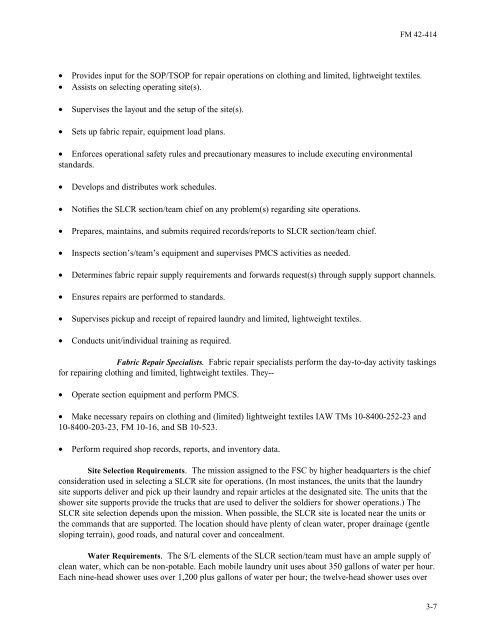Tactics, techniques, and procedures for - Army Electronic ...
Tactics, techniques, and procedures for - Army Electronic ...
Tactics, techniques, and procedures for - Army Electronic ...
Create successful ePaper yourself
Turn your PDF publications into a flip-book with our unique Google optimized e-Paper software.
FM 42-414<br />
• Provides input <strong>for</strong> the SOP/TSOP <strong>for</strong> repair operations on clothing <strong>and</strong> limited, lightweight textiles.<br />
• Assists on selecting operating site(s).<br />
• Supervises the layout <strong>and</strong> the setup of the site(s).<br />
• Sets up fabric repair, equipment load plans.<br />
• En<strong>for</strong>ces operational safety rules <strong>and</strong> precautionary measures to include executing environmental<br />
st<strong>and</strong>ards.<br />
• Develops <strong>and</strong> distributes work schedules.<br />
• Notifies the SLCR section/team chief on any problem(s) regarding site operations.<br />
• Prepares, maintains, <strong>and</strong> submits required records/reports to SLCR section/team chief.<br />
• Inspects section’s/team’s equipment <strong>and</strong> supervises PMCS activities as needed.<br />
• Determines fabric repair supply requirements <strong>and</strong> <strong>for</strong>wards request(s) through supply support channels.<br />
• Ensures repairs are per<strong>for</strong>med to st<strong>and</strong>ards.<br />
• Supervises pickup <strong>and</strong> receipt of repaired laundry <strong>and</strong> limited, lightweight textiles.<br />
• Conducts unit/individual training as required.<br />
Fabric Repair Specialists. Fabric repair specialists per<strong>for</strong>m the day-to-day activity taskings<br />
<strong>for</strong> repairing clothing <strong>and</strong> limited, lightweight textiles. They--<br />
• Operate section equipment <strong>and</strong> per<strong>for</strong>m PMCS.<br />
• Make necessary repairs on clothing <strong>and</strong> (limited) lightweight textiles IAW TMs 10-8400-252-23 <strong>and</strong><br />
10-8400-203-23, FM 10-16, <strong>and</strong> SB 10-523.<br />
• Per<strong>for</strong>m required shop records, reports, <strong>and</strong> inventory data.<br />
Site Selection Requirements. The mission assigned to the FSC by higher headquarters is the chief<br />
consideration used in selecting a SLCR site <strong>for</strong> operations. (In most instances, the units that the laundry<br />
site supports deliver <strong>and</strong> pick up their laundry <strong>and</strong> repair articles at the designated site. The units that the<br />
shower site supports provide the trucks that are used to deliver the soldiers <strong>for</strong> shower operations.) The<br />
SLCR site selection depends upon the mission. When possible, the SLCR site is located near the units or<br />
the comm<strong>and</strong>s that are supported. The location should have plenty of clean water, proper drainage (gentle<br />
sloping terrain), good roads, <strong>and</strong> natural cover <strong>and</strong> concealment.<br />
Water Requirements. The S/L elements of the SLCR section/team must have an ample supply of<br />
clean water, which can be non-potable. Each mobile laundry unit uses about 350 gallons of water per hour.<br />
Each nine-head shower uses over 1,200 plus gallons of water per hour; the twelve-head shower uses over<br />
3-7

















